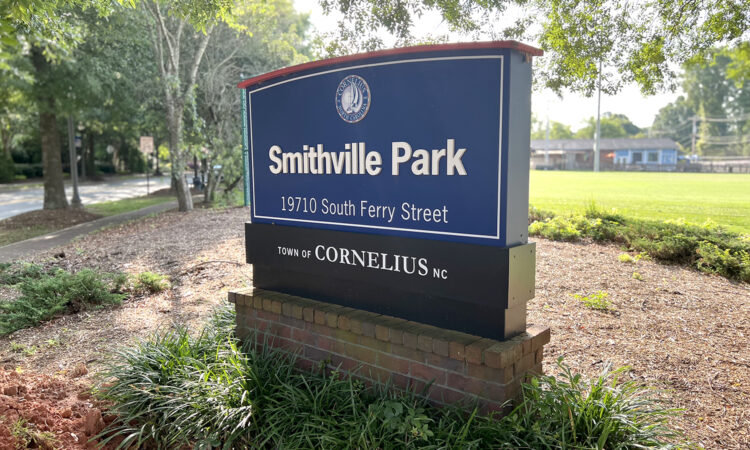 RENEWAL | By Erica Batten
RENEWAL | By Erica Batten
July 19. In the year since the Town of Cornelius approved the small-area plan proposed by the Smithville Community Coalition, the nonprofit has been steadily moving forward with its revitalization and affordable housing efforts for the historically African American community in the heart of Cornelius.
A tour of the area, with some run-down houses and neglected roads, might not be convincing. As with any endeavor involving government red tape and necessarily creative financing, orchestrating the key players–investors, donors, residents, and representatives, not to mention the Coalition staff—toward its shared goals has been challenging.
But there is quiet progress.
Most visibly, the nonprofit organization recently moved into a new office on Catawba Avenue. They have made a lot of operational and organizational updates, said Cornelius Town Board Member Denis Bilodeau.
“It went from a concept and a discussion to, now, action,” Bilodeau said.

Jones
Smithville Community Coalition Executive Director Willie Jones said bringing Smithville back to life involves significant change in a short period of time. A major source of funds is federal dollars awarded through the American Recovery Plan Act, which must be expended by the end of 2024. The time crunch is exacerbated by outside investors looking to capitalize on properties as they become available.
“We’ve always been under a clock,” Jones said. “Don’t expect a very smooth process because the area hasn’t had any investment in a century.”
History in our midst
Smithville was annexed into the Town of Cornelius in 1972. It spans 37 acres just east of I-77 along Catawba Avenue. Today, nearly half of the 154 parcels are unoccupied structures or empty lots. The owner-occupied units are overwhelmingly populated by seniors whose ability to accrue wealth during their working years was stifled by historic racial injustices. Now dependent on Social Security income, many cannot afford even critical repairs to their aging homes.
The plan
The SCC, which was originally founded in 1968, aims at four objectives: to prevent displacement of Smithville’s population; to eliminate blight and create value; to connect with Cornelius while maintaining a distinct neighborhood feel; and to reposition Smithville as a vibrant, forward-looking community. Jones called the SCC’s aims “a social service mission that is cloaked in real estate development.”
Published in December 2021, the SCC’s plan includes construction of 167 units aimed mainly at working-class residents—that is, people making between 30 and 120 percent of median income for the area. According to the U.S. Census Bureau, the median income in Cornelius as of 2021 was $95,147. Forty existing homes will be renovated. The plan also calls for expansion of Smithville Park, road and sidewalk improvements, a community park and historic preservation in and around the Rosenwald School.
Anticipated funding sources include federal, county, and town investments along with home sales, private philanthropy and loan repayments totaling more than $21 million.
Rather than being allocated directly to the SCC, federal dollars will be managed through contracts with Mecklenburg County requiring the nonprofit to submit budgets and documentation showing how the funds are being used.
As in a typical development plan, the improvements will proceed in phases based on area. The first phase, centered on the southernmost end of Smithville, is currently undergoing survey. By early fall, the SCC plans to submit a zoning application for 22 townhomes and single-family units. Three commercial buildings are also planned within this phase.
Another phase, in the center of the neighborhood, includes the historic Rosenwald School building, one of hundreds of schools established for African Americans in the South a century ago. The SCC is working with Congresswoman Alma Adams to explore options for federal historic preservation funding of the school and surrounding properties. In May, a municipal representative completed a site investigation as required by the National Trust for Historic Preservation.
Jones, his father, and his grandmother all attended a Rosenwald school, so renovation of this property holds personal significance for him. Perhaps more significant, though, is the impact a historic designation would have on the aging occupants of the homes in this phase. Combining the 50 percent tax reduction available to historic properties with the abatements available to seniors would practically eliminate their tax burden, Jones said.
In the phase adjacent to Smithville Park along Catawba Avenue, the SCC expects to submit a zoning application in the fall for multi-family rental housing up to three stories. They’re still looking for a developer there.
In all phases, the SCC has worked with the Charlotte-based architecture firm Neighboring Concepts so that the neighborhood will have a cohesive look.
“I’ve seen some renderings of what those units would look like,” Bilodeau said. “They’ve done things where they’re nice looking, but they fit the community.”
In the existing owner-occupied homes, the SCC has partnered with Habitat for Humanity to complete critical home repairs, such as roofing, plumbing, and HVAC. On average, each home will need around $50,000 in improvements. So far, 15 homes have been approved for repairs and three more are being considered.
Lots of progress
As for acquisitions, the SCC has already closed on 11 of the 20 lots it plans to buy, and it has made offers on six others.
The town has provided a $250,000 grant to remove lead piping between existing homes and public water and sewer infrastructure. The town has also allocated $3 million for street and sidewalk improvements.
While revitalization is underway, the SCC continues to develop strategies to strengthen existing community investment and streamline their operations. This week, it will begin surveying residents for a new case-managed program helping participants overcome obstacles to home ownership, such as poor credit. The nonprofit has submitted grant requests to two foundations to support the program, and it is discussing with lenders options for special mortgages.
Challenges
The challenges to Smithville revitalization are even more numerous than the facets of the plan itself. As an example, Jones said the nonprofit is currently competing directly with investors on four parcels.
“Because of the lower assessed and appraisal values, African American communities have become targets of investors and developers who have access to significant capital,” Jones said.
Though the area is increasingly attractive to investors, another challenge is connectivity with surrounding roads. Many of the homes on the south side of Smithville, though they are close in proximity to Statesville Road, have no road access there or at Nannie Potts Lane. This is a liability which Jones is looking to the town to remedy.
Jones and his team have also faced opposition within the community, most vocally from longtime community residents.
Being an outsider—Jones hails from rural Virginia and has lived in Detroit and Boston, among other Northern cities—has made building trust a slower process. Some Smithville residents are opposed to change in general or are in need of auxiliary services, such as transportation or disability services, should they choose to temporarily relocate while critical repairs are being done to their homes.
Buy-in is real
Overall, though, support for the project is gaining headway within the community. Jones has four decades of experience in community revitalization in nearly a dozen states. And in a 2021 survey conducted by the SCC, upwards of 90 percent of Smithville residents were in favor of the revitalization plan.

Bilodeau
Bilodeau praised the community’s buy-in. “It went from some folks completely shut down to now talking about issues,” he said.
Bilodeau noted that another recent challenge the SCC has faced has stemmed from the town’s recent property tax revaluation. Once owners see the new valuation on their homes, they’re looking to capitalize. As noted earlier, outside developers are all too ready to pounce, and the problem will only get worse once infrastructure improvements are completed, Jones said.
Internally, the nonprofit has faced some issues with staffing. They’re looking to replace the former operations manager and are also seeking other project managers to help integrate the various aspects of the plan.
To ease staffing pressures, the SCC is seeking Americorps funding for an assistant project manager. They also plan to bring on an intern to help manage private donations.
Complexities all around
With government funding comes not only a timeline, but also specific requirements regarding affordable housing. ARPA funding caps income for qualifying households at 65 percent of the area’s median income, while other funds allow up to 80 percent, so, in order to be compliant, units will be mixed within various phases of development.
Other complexities involve scheduling. The SCC owns five vacant Smithville homes that it plans to demolish. The homes are located in an area that has consistently flooded, causing irreconcilable mold issues. But rather than begin demolition, the SCC is waiting to gain access to a sixth home so that all of the demolition can be done in one time period, minimizing disruption and streamlining costs.
Temporarily relocating residents presents an array of challenges. One man owns a pit bull, which isn’t accepted in most rentals. Other families require up to three separate temporary homes in order to relocate the head of household, disabled dependents, and caregivers in compliance with law. Currently, ten families are living in temporary rental housing while their homes are undergoing critical repairs.
Why Smithville?
One of the most persistent challenges comes from outside Smithville.
“What I’ve heard, and what I’ve been challenged with is: Why should I do something special for the African American community?” Jones said.
But Jones has practical answers for those kinds of questions. In the long run, the local government saves money through critical home repairs because it reduces expenditures on services such as nursing homes by allowing seniors to age in place, he said.
The housing developments will also help address the town’s larger affordable housing issue by providing options for town employees, teachers, and other workers whose salaries fall far below the area’s median income. And because of the density of development, Smithville’s residential units will actually generate more property tax revenue than those in other areas of town.
“When you get public investment, you can get outcomes that benefit the public,” Jones said.
The vision
To address the larger vision of Smithville, the community must balance respect for the existing population while attracting and integrating newcomers. In the end, Jones said, there will be more new people than old. He hopes to attract people who work in the public sector and are used to interacting with a diverse population.
Depending on the ultimate outcome, Smithville could serve as a template for other communities looking to revitalize through a network of partnerships. Already, the Affordable Housing Equity Board in Davidson has discussed following Smithville’s lead regarding revitalization of Historic West Davidson, another historically African American neighborhood. The potential for such a model to have both generational and wide-ranging geographical ripple effects is what ultimately drives the Smithville mission.
Jones said, “This is a model that, if done correctly, can impact thousands of lives.”




